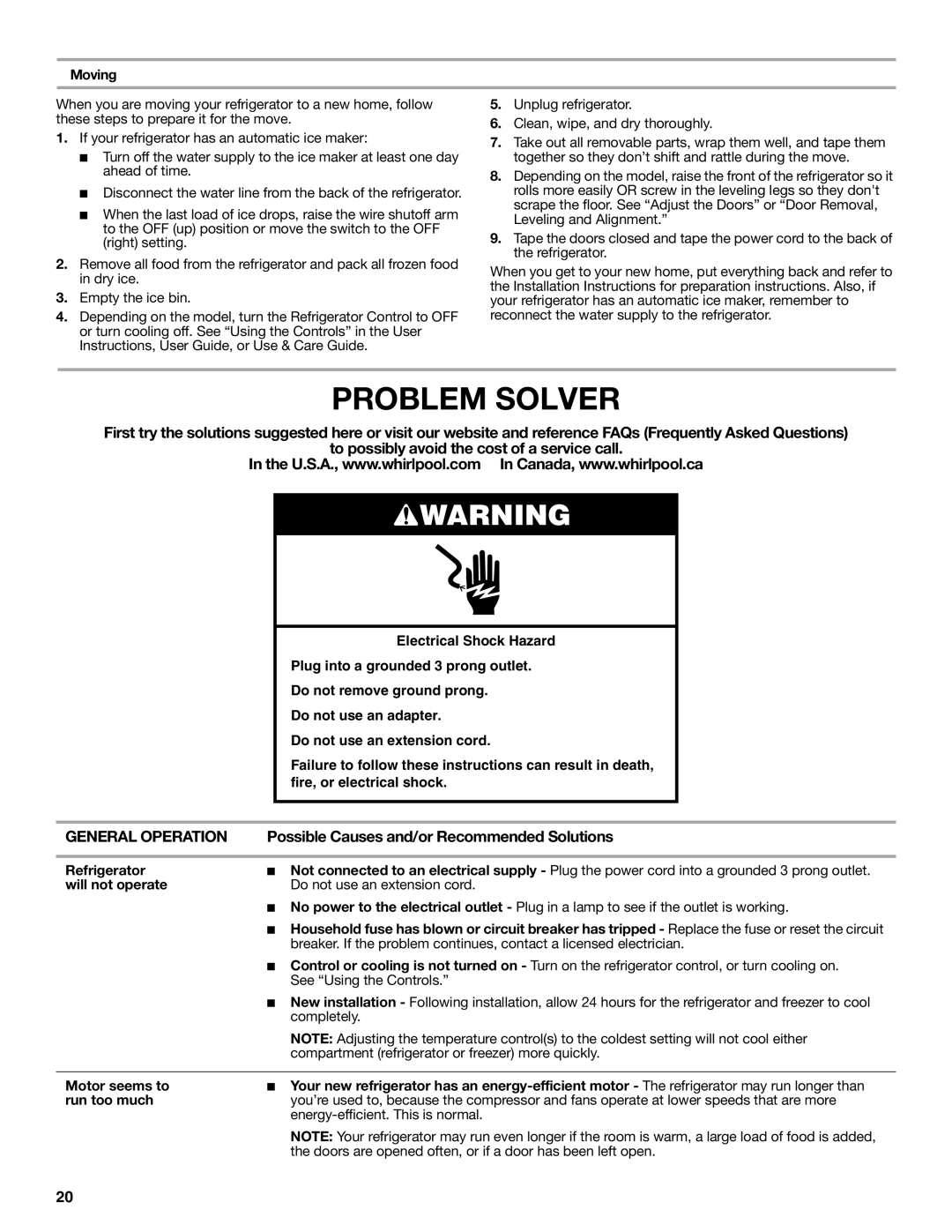
Moving
When you are moving your refrigerator to a new home, follow | 5. | Unplug refrigerator. | ||
these steps to prepare it for the move. | 6. | Clean, wipe, and dry thoroughly. | ||
1. If your refrigerator has an automatic ice maker: | ||||
7. | Take out all removable parts, wrap them well, and tape them | |||
| ■ Turn off the water supply to the ice maker at least one day |
| together so they don’t shift and rattle during the move. | |
| ahead of time. | 8. | Depending on the model, raise the front of the refrigerator so it | |
|
| |||
| ■ Disconnect the water line from the back of the refrigerator. |
| rolls more easily OR screw in the leveling legs so they don't | |
| ■ When the last load of ice drops, raise the wire shutoff arm |
| scrape the floor. See “Adjust the Doors” or “Door Removal, | |
|
| Leveling and Alignment.” | ||
| to the OFF (up) position or move the switch to the OFF |
| ||
| 9. | Tape the doors closed and tape the power cord to the back of | ||
| (right) setting. | |||
|
| the refrigerator. | ||
2. Remove all food from the refrigerator and pack all frozen food |
| |||
When you get to your new home, put everything back and refer to | ||||
| in dry ice. | |||
| the Installation Instructions for preparation instructions. Also, if | |||
3. Empty the ice bin. | ||||
your refrigerator has an automatic ice maker, remember to | ||||
4. Depending on the model, turn the Refrigerator Control to OFF | reconnect the water supply to the refrigerator. | |||
| or turn cooling off. See “Using the Controls” in the User |
|
| |
| Instructions, User Guide, or Use & Care Guide. |
|
| |
|
|
|
| |
PROBLEM SOLVER
First try the solutions suggested here or visit our website and reference FAQs (Frequently Asked Questions)
to possibly avoid the cost of a service call.
In the U.S.A., www.whirlpool.com In Canada, www.whirlpool.ca
![]() WARNING
WARNING
|
| Electrical Shock Hazard | |
|
| Plug into a grounded 3 prong outlet. | |
|
| Do not remove ground prong. | |
|
| Do not use an adapter. | |
|
| Do not use an extension cord. | |
|
| Failure to follow these instructions can result in death, | |
|
| fire, or electrical shock. | |
|
|
|
|
|
|
|
|
GENERAL OPERATION | Possible Causes and/or Recommended Solutions | ||
|
|
|
|
Refrigerator | ■ Not connected to an electrical supply - Plug the power cord into a grounded 3 prong outlet. | ||
will not operate |
| Do not use an extension cord. | |
| ■ No power to the electrical outlet - Plug in a lamp to see if the outlet is working. | ||
| ■ Household fuse has blown or circuit breaker has tripped - Replace the fuse or reset the circuit | ||
|
| breaker. If the problem continues, contact a licensed electrician. | |
| ■ Control or cooling is not turned on - Turn on the refrigerator control, or turn cooling on. | ||
|
| See “Using the Controls.” | |
| ■ New installation - Following installation, allow 24 hours for the refrigerator and freezer to cool | ||
|
| completely. | |
|
| NOTE: Adjusting the temperature control(s) to the coldest setting will not cool either | |
|
| compartment (refrigerator or freezer) more quickly. | |
|
|
|
|
Motor seems to | ■ Your new refrigerator has an | ||
run too much |
| you’re used to, because the compressor and fans operate at lower speeds that are more | |
|
| ||
|
| NOTE: Your refrigerator may run even longer if the room is warm, a large load of food is added, | |
|
| the doors are opened often, or if a door has been left open. | |
20
